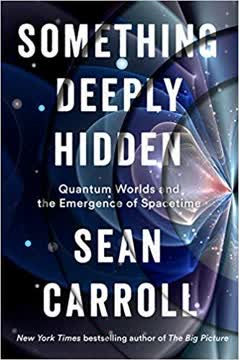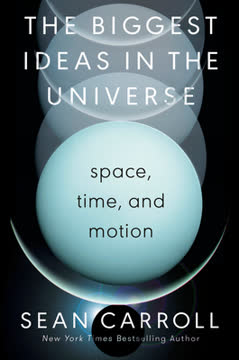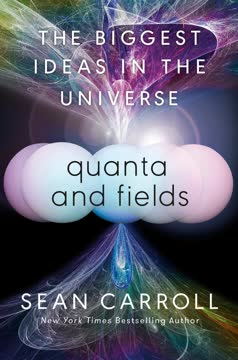Key Takeaways
1. Quantum Mechanics Challenges Our Classical Understanding of Reality
"The world is a quantum state evolving in Hilbert space, and physical space emerges out of that."
Quantum Weirdness Defined. Quantum mechanics fundamentally challenges our intuitive understanding of reality, presenting a world that operates differently from classical physics. Unlike Newton's predictable universe, quantum mechanics introduces fundamental uncertainty and probabilistic behavior at the microscopic level.
Key Quantum Principles:
- Particles can exist in multiple states simultaneously
- Observation fundamentally changes quantum systems
- Precise measurement of certain properties is impossible
- Reality is probabilistic, not deterministic
Paradigm Shift. Quantum mechanics reveals that our everyday experience of reality is merely an approximation of a much more complex underlying quantum world. This understanding requires us to abandon classical notions of definite positions, trajectories, and absolute predictability.
2. The Wave Function is the Fundamental Description of Reality
"Quantum mechanics isn't magic. It is the deepest, most comprehensive view of reality we have."
Wave Function as Ultimate Reality. In quantum mechanics, the wave function represents the most fundamental description of a physical system. It's not just a mathematical tool, but a representation of the actual state of reality, containing all possible information about a quantum system.
Characteristics of Wave Functions:
- Describes probability amplitudes for different outcomes
- Evolves deterministically according to Schrödinger's equation
- Contains information about all possible quantum states
- Represents a superposition of potential realities
Beyond Classical Descriptions. The wave function provides a radically different perspective on reality, suggesting that what we perceive is just one potential manifestation of an infinitely more complex quantum state.
3. Measurement Reveals Only a Fraction of Quantum Complexity
"We don't know what's really going on, or at least the community of professional physicists cannot agree on what it is."
Limited Observable Reality. Quantum mechanics suggests that measurement reveals only a tiny fraction of the underlying quantum complexity. When we observe a quantum system, we collapse its wave function, losing most of the potential information.
Measurement Implications:
- Observation fundamentally alters quantum systems
- Most potential states become inaccessible upon measurement
- The act of observation is not neutral but transformative
- Quantum systems exist in multiple states before measurement
Epistemological Challenge. This principle highlights the profound limitation of human perception and measurement, suggesting that our understanding of reality is inherently constrained by our observational methods.
4. Many-Worlds Interpretation Offers a Deterministic Quantum Perspective
"Many-Worlds describes the universe using a single mathematical object, the wave function."
Everett's Quantum Vision. The Many-Worlds interpretation proposes that all possible quantum outcomes occur simultaneously in different branches of reality. Instead of random collapse, the wave function smoothly evolves, creating multiple concurrent worlds.
Key Many-Worlds Principles:
- One universal wave function describes all possible realities
- Each quantum event creates branching worlds
- No wave function collapse occurs
- All potential outcomes are real
Philosophical Implications. Many-Worlds provides a deterministic alternative to traditional quantum interpretations, suggesting a universe of infinite parallel realities continuously emerging from quantum interactions.
5. Entanglement is a Fundamental Quantum Phenomenon
"Entanglement is the secret ingredient."
Quantum Interconnectedness. Entanglement represents a profound quantum connection where particles become intrinsically linked, regardless of physical distance. When two particles become entangled, their quantum states are interdependent.
Entanglement Characteristics:
- Instantaneous correlations between distant particles
- Defies classical notions of local causality
- Fundamental to quantum information processing
- Suggests deep underlying interconnectedness of reality
Beyond Classical Physics. Entanglement demonstrates that quantum systems can have instantaneous connections that transcend classical physical limitations, challenging traditional understanding of space and interaction.
6. Probability in Quantum Mechanics is Fundamentally Different
"Probability in Many-Worlds is necessarily a statement about what we should believe and how we should act, not about how often things happen."
Quantum Probability Redefined. Quantum probability is not about frequency of events but about potential outcomes and observer perspective. It represents a fundamentally different approach to understanding uncertainty.
Probabilistic Characteristics:
- Probabilities derived from wave function amplitudes
- Based on potential quantum states
- Relates to observer's knowledge and potential outcomes
- Not a measure of actual event occurrence
Epistemological Shift. This approach transforms probability from a statistical tool to a fundamental description of quantum reality's inherent uncertainty.
7. Space and Time May Be Emergent Phenomena
"Space isn't fundamental; it's just a way to organize what's going on in the underlying quantum wave function."
Quantum Spacetime Origin. Space and time might not be fundamental properties but emergent phenomena arising from quantum entanglement and information relationships.
Emergence Principles:
- Spacetime could arise from quantum interactions
- Geometry potentially constructed from entanglement
- Physical space might be a convenient approximation
- Quantum degrees of freedom potentially create spatial relationships
Radical Reimagining. This perspective suggests that our fundamental conception of reality might be more fluid and information-based than our classical understanding suggests.
8. Quantum Mechanics Extends Beyond Particle Physics
"Everything is quantum."
Quantum Ubiquity. Quantum mechanics is not limited to subatomic particles but potentially describes fundamental aspects of reality across scales.
Quantum Applications:
- Fundamental to modern technology
- Crucial in understanding chemical interactions
- Relevant to biological processes
- Essential for emerging technologies like quantum computing
Technological Implications. Understanding quantum mechanics opens possibilities for revolutionary technological and scientific advancements.
9. The Foundations of Quantum Mechanics Remain Mysterious
"Despite the unrivaled empirical success of quantum theory, the very suggestion that it may be literally true as a description of nature is still greeted with cynicism, incomprehension, and even anger."
Ongoing Scientific Puzzle. Despite decades of research, the fundamental nature of quantum mechanics remains incompletely understood, with multiple competing interpretations.
Foundational Challenges:
- Lack of consensus on quantum interpretation
- Philosophical disagreements persist
- Measurement problem remains unresolved
- Multiple theoretical approaches exist
Scientific Humility. The ongoing mystery of quantum mechanics underscores the importance of continued research and openness to radical new perspectives.
10. Quantum Theory Has Profound Implications for Our Understanding of Reality
"Something deeply hidden had to be behind things."
Reality Reimagined. Quantum mechanics suggests a reality far more complex, interconnected, and probabilistic than classical physics proposed.
Philosophical Implications:
- Challenge to deterministic worldview
- Suggests fundamental uncertainty
- Hints at deeper interconnectedness
- Expands conception of possible realities
Transformative Understanding. Quantum theory invites us to reimagine reality as a dynamic, probabilistic, interconnected system beyond classical intuitions.
Last updated:
FAQ
What's Something Deeply Hidden about?
- Exploration of Quantum Mechanics: The book delves into the foundations of quantum mechanics, focusing on the Many-Worlds interpretation, which suggests that all possible outcomes of quantum measurements occur in separate, branching universes.
- Philosophical and Scientific Inquiry: Sean Carroll combines scientific rigor with philosophical inquiry, challenging readers to rethink their perceptions of reality and emphasizing that quantum mechanics is a profound description of the universe.
- Interconnectedness of Concepts: Carroll discusses how quantum mechanics connects to broader concepts like spacetime and gravity, suggesting that understanding quantum mechanics is crucial for grasping the nature of the universe.
Why should I read Something Deeply Hidden?
- Accessible to All Readers: Carroll presents complex ideas in a clear and engaging manner, making them accessible to readers without a background in physics.
- Challenging Conventional Thinking: The book encourages readers to confront their intuitions about reality and consider the implications of quantum mechanics.
- Insight into Current Research: Carroll provides insights into ongoing debates and research in quantum mechanics, particularly the Many-Worlds interpretation.
What are the key takeaways of Something Deeply Hidden?
- Understanding Quantum Weirdness: Quantum mechanics, often perceived as "spooky," is a coherent and essential part of modern physics, and Carroll argues it should be understood as a fundamental description of reality.
- Many-Worlds Interpretation: Carroll advocates for the Many-Worlds interpretation as a compelling way to make sense of quantum phenomena, eliminating the need for wave function collapse.
- Interplay of Science and Philosophy: The book highlights the philosophical implications of quantum mechanics, urging readers to consider what it means for concepts like reality, observation, and existence.
What are the best quotes from Something Deeply Hidden and what do they mean?
- “I think I can safely say that nobody understands quantum mechanics.”: This quote by Richard Feynman encapsulates the mystery surrounding quantum mechanics, highlighting the challenges even experts face in grasping its full implications.
- “Quantum mechanics isn’t magic. It is the deepest, most comprehensive view of reality we have.”: Carroll asserts that while quantum mechanics may seem strange, it is a profound and accurate description of the universe.
- “The wave function is the sum total of reality.”: This statement emphasizes the importance of the wave function in quantum mechanics, suggesting that it encapsulates all possible states of a system.
What is the Many-Worlds interpretation discussed in Something Deeply Hidden?
- Branching Universes Concept: The Many-Worlds interpretation posits that every quantum measurement results in the universe branching into multiple, non-communicating realities.
- No Wave Function Collapse: Unlike traditional interpretations, Many-Worlds eliminates the need for wave function collapse, suggesting that all outcomes are realized.
- Philosophical Implications: The interpretation raises questions about identity and existence, as individuals in different branches of the universe may have different experiences.
How does Something Deeply Hidden explain the measurement problem in quantum mechanics?
- Measurement as Interaction: Carroll explains that measurement in quantum mechanics is not a special process but rather an interaction between systems.
- Decoherence and Branching: Decoherence causes the wave function to branch into separate realities, each corresponding to different measurement outcomes.
- No Special Rules Needed: Carroll argues that the evolution of the wave function according to the Schrödinger equation suffices, simplifying the understanding of quantum mechanics.
What role does decoherence play in Something Deeply Hidden?
- Decoherence Explained: Decoherence is the process by which quantum systems lose their quantum behavior and become classical due to interactions with their environment.
- Branching of the Wave Function: Decoherence leads to the branching of the wave function, resulting in multiple, non-communicating worlds.
- Connection to Classical Reality: Carroll argues that decoherence helps bridge the gap between quantum mechanics and classical physics.
How does Something Deeply Hidden address the concept of probability in quantum mechanics?
- Born Rule Derivation: Carroll discusses how the Born rule arises naturally in the context of Many-Worlds, essential for understanding probabilities.
- Epistemic vs. Frequentist Probability: The book contrasts epistemic probability with frequentist probability, arguing that in Many-Worlds, probabilities reflect our credences about different branches.
- Self-Locating Uncertainty: Carroll introduces self-locating uncertainty, where individuals assign probabilities based on their lack of knowledge about which branch they inhabit.
What is the significance of entanglement in Something Deeply Hidden?
- Entanglement Defined: Entanglement is a quantum phenomenon where the states of particles become correlated, affecting each other instantaneously.
- EPR Paradox: The book discusses the EPR paper, which raised questions about the completeness of quantum mechanics due to entanglement's nonlocal nature.
- Implications for Reality: Carroll argues that entanglement challenges our understanding of reality, suggesting interconnectedness that defies classical notions.
How does Something Deeply Hidden relate quantum mechanics to spacetime and gravity?
- Emergence of Spacetime: Carroll explores the idea that spacetime may emerge from quantum mechanics, rather than being a fundamental backdrop.
- Quantum Gravity: The book discusses the quest for a theory of quantum gravity, seeking to unify quantum mechanics with general relativity.
- Interconnectedness of Concepts: Carroll emphasizes the complex relationship between quantum mechanics, spacetime, and gravity.
What are the implications of quantum mechanics for free will, as discussed in Something Deeply Hidden?
- Determinism vs. Free Will: Carroll explores the tension between the deterministic nature of quantum mechanics and the concept of free will.
- Emergence of Choice: The book posits that our perception of making choices is a result of complex interactions within our brains.
- Philosophical Considerations: Carroll encourages readers to consider the implications of quantum mechanics on personal identity and moral responsibility.
What challenges does Something Deeply Hidden identify in the quest for a quantum theory of gravity?
- Technical Difficulties: The book discusses the significant technical challenges in quantizing general relativity.
- Conceptual Issues: Carroll highlights the conceptual difficulties in reconciling quantum mechanics with the nature of spacetime.
- Experimental Limitations: The author points out the lack of experimental data to guide the development of a quantum theory of gravity.
Review Summary
Something Deeply Hidden explores quantum mechanics and the Many Worlds interpretation. Carroll argues for this perspective, presenting it as the most straightforward and elegant explanation of quantum phenomena. The book covers quantum foundations, entanglement, and potential implications for quantum gravity. Readers found it challenging but insightful, praising Carroll's clear explanations of complex concepts. Some disagreed with his strong advocacy for Many Worlds, while others appreciated the thorough examination of quantum theory. The book's later chapters on quantum gravity and spacetime emergence were particularly thought-provoking for many readers.
Download PDF
Download EPUB
.epub digital book format is ideal for reading ebooks on phones, tablets, and e-readers.








